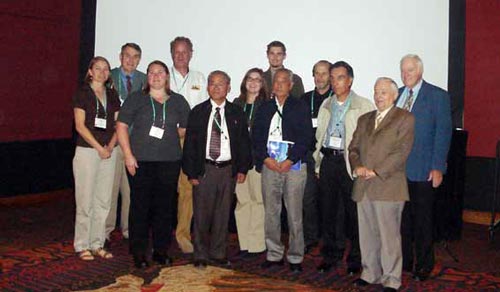 An extraordinary session of the ASA/CSSA/SSSA convention in San Antonio, Texas, during 16-19 October 2011, honored researchers who have dedicated their professional lives to understanding and using the diversity of the amazing food crop, maize, and its wild relatives Tripsacum and teosinte. Entitled “The mysteries of maize: A recognition of pillars in maize science,” the session paid tribute to the careers of Major Goodman, Hugh Iltis, Takeo Ángel Kato Yamakake, Wilfredo Salhuana, José de Jesús Sánchez González, and H. Garrison Wilkes, as well as CIMMYT’s own Suketoshi Taba and José Crossa.
An extraordinary session of the ASA/CSSA/SSSA convention in San Antonio, Texas, during 16-19 October 2011, honored researchers who have dedicated their professional lives to understanding and using the diversity of the amazing food crop, maize, and its wild relatives Tripsacum and teosinte. Entitled “The mysteries of maize: A recognition of pillars in maize science,” the session paid tribute to the careers of Major Goodman, Hugh Iltis, Takeo Ángel Kato Yamakake, Wilfredo Salhuana, José de Jesús Sánchez González, and H. Garrison Wilkes, as well as CIMMYT’s own Suketoshi Taba and José Crossa.
The session was moderated by Carolyn Lawrence, assistant professor at Iowa State University and a member of the US Department of Agriculture (USDA-ARS) team managing the Maize Genetics & Genomics Database (MaizeGDB). Wilkes led off with a presentation about the in-situ conservation of teosinte and its co-evolution with maize. Among the other speakers, Taba talked about the potential for further use of the Mexican maize race Tuxpeño in future breeding work and thanked participants for their collaboration, consultation, and encouragement in developing the CIMMYT maize collection during his career. Closing the session was former CIMMYT molecular biologist and current USDA-ARS research geneticist Marilyn Warburton, who discussed issues around the use and conservation of the Zea gene pool.
Profiles of the pillars. A professor at the Colegio de Postgraduados, Kato is among many distinguished Mexican scientists whose contributions to research on maize evolution and diversity predate the advent of DNA markers; besides elucidating chromosome knob patterns for American maize races, he studied in partnership with late Nobel Laureate and cytogeneticist Barbara McClintock the possible migration and integration of maize germplasm. University of Guadalajara professor the collection and characterization of Mexican maize races and teosinte, the wild relative from which maizedirectly evolved.
During many years as a researcher at Pioneer, Salhuana was instrumental in efforts to identify and transfer useful diversity from tropical to temperate maize. Professor Emeritus of Botany at the University of Wisconsin–Madison, Iltis is best known for studies on the domestication of maize, for leading a team of botanists who discovered the Zea diploperennis teosinte species, and for advocating the conservation of teosinte in natural habitats. Director of Maize Breeding and Genetics at North Carolina State University, Goodman helped lay the genetics and breeding groundwork to clarify and synthesize relationships among maize genetic resources, and has strongly supported the conservation of Latin American maize.
In addition to his interest in the evolution of maize, retired University of Massachusetts at Boston professor Wilkes has focused on economic botany, the genetics of domestication, and the promotion of effective gene banks and policies to conserve and use plant genetic resources. A regular visitor to CIMMYT, Wilkes helped improve and strengthen the center’s maize seed conservation systems and its global role as a genetic resource preserver and promoter.
Retired CIMMYT biometrician and distinguished scientist Crossa has helped define key methodologies for conserving and using the center’s maize genetic resources, including proper procedures to regenerate older seed samples or to form representative subsets of large collections. The head of maize genetic resources, Taba has worked at CIMMYT since 1975. His many accomplishments include coordinating the work of national seed banks in 13 Latin American countries to rescue and regenerate more than 15,000 endangered seed collections of native maize races. He has also pioneered farmer participatory approaches to improve maize landraces while retaining essential qualities that farmers value, and has developed core subsets of major maize race collections. Finally, his abiding interest in conserving and studying maize wild relatives has expanded CIMMYT’s teosinte collections and lately led to his discovery of a new perennial teosinte in western Mexico.
“Maize’s domestication over 9,000 years from teosinte to a productive food crop is an incredible story,” said Taba. “These scientists have helped bring it to light, as well as defining the diversity that will give maize farmers new traits to meet the challenges of food scarcity and climate change.”
The special session was organized by Tom Payne, head of wheat genetic resources at CIMMYT, and Candice Gardener, research leader / supervisory plant biologist for the US Department of Agriculture (USDA-ARS-MWA-PIRU).
 Capacity development
Capacity development 
